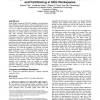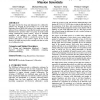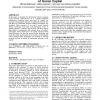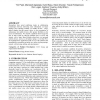ESAW
2004
Springer
14 years 4 months ago
2004
Springer
The development of multi-agent systems (MAS) implies considering both the social and individual levels of these systems. However, the elements in these levels are not necessarily c...
CSCW
2004
ACM
14 years 5 months ago
2004
ACM
The Meeting Central prototype is a suite of collaboration tools designed to support distributed meetings. The tools' minimalist design provides only those features that have ...
CSCW
2004
ACM
14 years 5 months ago
2004
ACM
The needs of blind and visually impaired users are seriously under-investigated in CSCW. We review work on assistive interfaces especially concerning how collaboration between sig...
CSCW
2004
ACM
14 years 5 months ago
2004
ACM
Single Display Groupware (SDG) lets multiple co-located people, each with their own input device, interact simultaneously over a single communal display. While SDG is beneficial, ...
CSCW
2004
ACM
14 years 5 months ago
2004
ACM
This paper describes the design and deployment of a collaborative software tool, designed for and presently in use on the Mars Exploration Rovers (MER) 2003 mission. Two central q...
CSCW
2004
ACM
14 years 5 months ago
2004
ACM
This paper reports from a study of Norwegian medical emergency call (AMK) centres, in which advanced radio and telephone communication technologies are handled by a team of nurses...
CSCW
2004
ACM
14 years 5 months ago
2004
ACM
This paper presents research on the use of household lists. Drawing on an ethnographic study of mothers’ work, it focuses on the centrality of paper lists in home- and child-car...
CSCW
2004
ACM
14 years 5 months ago
2004
ACM
In this paper we examine the relationship between emergent social network characteristics in a computer-supported collaborative learning course and locus of control. An emergent c...
CSCW
2004
ACM
14 years 5 months ago
2004
ACM
Information hiding is one of the most important and influential principles in software engineering. It prescribes that software modules hide implementation details from other modu...
CSCW
2004
ACM
14 years 5 months ago
2004
ACM




